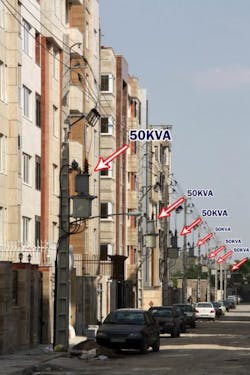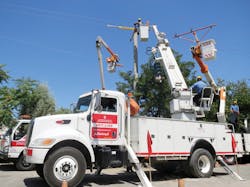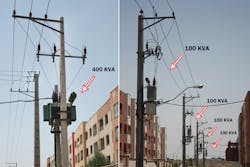Iran is located on one of the earth’s fault lines that stretches from China to Italy. In the past decade, the country has suffered some 950 earthquakes, and depending on the severity, they can cause immense damage to the infrastructure. In both urban and rural areas, the overhead line distribution networks have suffered severe damage.
Undoubtedly, the worst and most devastating earthquake occurred in December 2003 in the city of Bam in Kerman province, located in southeastern Iran. With a recorded 6.6 on the Richter scale, this major earthquake destroyed official and residential buildings as well as the water, electricity and telecommunications networks. Although Bam is within the geographical area supplied by the Kerman Electric Energy Distribution Co., the Mashhad Electric Energy Distribution Co. (MEEDC), located in northeastern Iran, recently reviewed the damage caused by this earthquake to the medium- and low-voltage (MV and LV) overhead line distribution networks.
Damage Caused by Earthquakes
The maximum vertical acceleration caused displacement of the aboveground electrical equipment, especially in areas with soft soil conditions. The damage was severe to pole-mounted transformers and pole-top accessories, with streetlight columns falling into urban area streets. The concrete poles used to support the overhead line conductors also failed.
The post-earthquake evidence and records examined by MEEDC pointed to these as the probable causes of failure:
- The installation of heavy, large-capacity three-phase MV/LV pole-mounted transformers with ratings up to 400 kVA
- The use of reinforced concrete poles designed with a square cross-section, as failure was attributable to rotation; this action, coupled with bending of the steel reinforcement embedded in the square poles, caused these supports to fail.
Iran also experiences other forms of natural disasters such as floods and storms, so MEEDC, in an effort to minimize its vulnerability to these events, extended its research with visits to and surveys of the design standards used in Japan, South Korea, Malaysia and Indonesia. These developed countries, located on the same earthquake fault line, have been applying modern technologies with reasonable success in controlling or minimizing the damage caused by natural disasters.
To improve the reliability and stability of existing overhead line networks, MEEDC was interested in the design and quality of the supporting structures and the use of new concepts. It soon became apparent that round concrete poles appeared to be more robust and able to withstand the increased stresses associated with earthquakes’ lateral inertia.
Concrete Pole Design Standards
Research has been undertaken by MEEDC and there have been various studies by Iranian experts on the ability of square-section steel-reinforced concrete poles manufactured by Iranian companies. Findings have shown they are not able to support heavy equipment under certain conditions. In particular, it was concluded, when subjected to earthquakes, their design had insufficient tensile strength to withstand the lateral inertia exerted during earthquakes. This problem is compounded in the form of foundation failure when heavy, larger kVA-rated three-phase transformers are installed on the concrete poles.
To supply the inevitable load growth from increasing city development and the continuing policy to construct overhead line distribution networks, the number of large-capacity three-phase transformers increased, thereby increasing the probability of failure and associated danger to the public from failing concrete poles. This was evident in the aftermath of the Bam earthquake.
Following the studies and experience MEEDC gathered from its discussions and visits to the earthquake-prone countries in East Asia, particularly Japan and South Korea, the utility decided to replace steel-reinforced square concrete poles used on MV and LV overhead lines with round concrete poles.
Fortunately, the technology used in the production of round concrete poles has now been adopted by several Iranian companies, which are now able to supply these poles with a higher tensile strength. MEEDC is using round concrete poles on new distribution networks, and it will gradually replace existing supports as its existing networks are reinforced or extended.
MEEDC hopes the changes made to its design standards for overhead line distribution networks including the design of its supporting concrete poles, which are approved by the Ministry of Energy (Tavanir), will ultimately be ratified and adopted as a national standard.
Pole-Mounted Transformer Design Standards
It has been proven experimentally that the weight of pole-mounted equipment and accessories has a detrimental effect on the structure’s resistance to natural disasters, particularly earthquakes. Therefore, MEEDC has revised its design standards for low-voltage overhead line distribution networks by replacing the larger kVA-rated three-phase transformers with lighter 100-kVA three-phase transformers.
This change in design policy was introduced two years ago, and retrofitting will continue wherever it is judged to be economically justifiable, as it introduces the following advantages:
- Decentralizes the LV network, reducing losses
- Reduces the theft of energy
- Reduces time associated with transformer installation and commissioning
- Reduces to one the number of overhead line supporting poles required for each installation.
MEEDC Resources
The majority of the utility’s core activities are executed by directly managed resources in line with the policy to invest in the training of individuals and groups of employees and contractors. Therefore, the utility’s employees perform all fault repairs and routine maintenance. Extensive training, particularly the construction and maintenance of overhead lines using live-line procedures, was introduced and, with the assistance of competent training agencies, staff are now authorized for this work in accordance with international standards.
As a result, live-line work is now used extensively on network retrofit activities, including the installation and replacement of MV and LV poles. These operations, which remove the need for circuit outages, have significantly improved the reliability of the overhead line distribution network.
Change Accomplished
To improve the withstand capability and reliability of electricity supply systems, it is necessary to take action at the design stage to minimize the effects and vulnerability of the network in the event of natural disasters. As custodians of the distribution networks in northeastern Iran, MEEDC has introduced some fundamental design changes now being applied to all new networks and in the rehabilitation of existing networks.
The electric distribution utilities in Iran have been privatized, so they can now establish their own policies and strategies. However, the utilities are still subject to a number of the Ministry of Energy’s standards and guidelines. MEEDC anticipates its recently introduced design standards for distribution network overhead lines — whereby lighter, small-capacity transformers are installed instead of large-capacity three-phase units, now approved by the Ministry of Energy — will ultimately be issued as a national standard.
Reza Nikpayam ([email protected]) is manager of the Mashhad Electric Energy Distribution Co.’s safety department. He also works as a consultant in technical protection for the Iran Ministry of Cooperation, Labor and Social Affairs. He has served as an accident investigator and expert witness, and has been responsible for training program development on electrical safety and general industry site monitoring standards.
Company mentioned:
MEEDC | www.meedc.net





